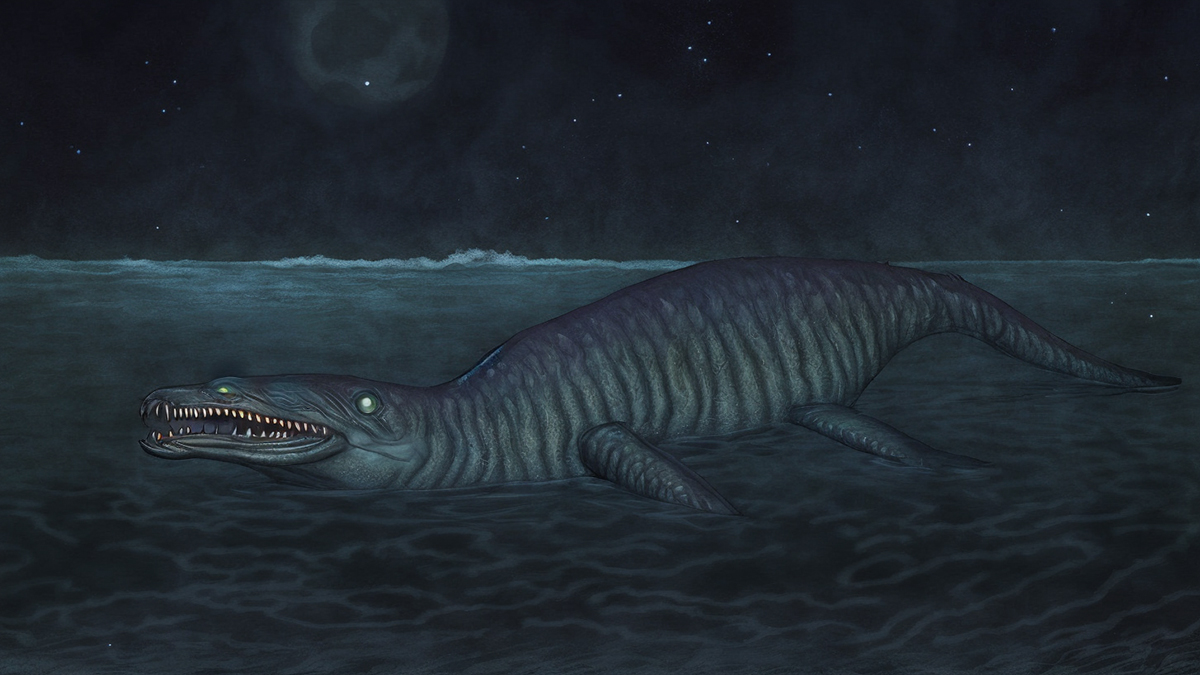Gambo is the name given to a purported sea monster that washed up on the Gambian seashore in 1983.
Description
Gambo, so the story goes, washed up on a beach in 1983 and has been the subject of speculation ever since. No one knows for sure what it was or what happened to its carcass – if indeed the creature was real.
The carcass is said to have been discovered on June 12, 1983, by an amateur naturalist named Oliver Burnham. Oliver was a teenager at the time and, although a British national, had spent much of his life in West Africa and had become familiar with the local fauna.
He says he came across Gambo while on a walk with his family. The creature was half-buried in the sand, and young Oliver took plenty of notes, studying the body to try to find out what it was. He did not, unfortunately, have a camera to hand.
Oliver’s notes present the image of an extraordinary creature. Showing no signs of composition, save for a torn rear flipper which revealed the intestines, the body struck Oliver as being very anomalous.
He recorded that the creature, which would become known as Gambo, was approximately 14 feet long and 5 feet wide and had brownish skin (not scaly) that faded to a paler color on the underbelly. Gambo had a short neck, and its dolphin-like head was around 5 feet long.
Small black eyes sat on each side of the head, and at the front of the head, there was a beak in the region of 2.5 feet long.
There were four paddle-like flippers, no sign of a dorsal fin, a tail of 5 feet, and an impressive beak, which housed 80 conical, sharp teeth. The front flippers measured around 1.5 feet long and 8 inches wide.
Initially believing the creature to be a cetacean, young Oliver became confused when he noted the nostrils on the creature’s snout. His confusion stemmed from the fact that cetaceans had evolved to lose their rear flippers and develop blow holes to replace their nostrils. (Cetaceans are aquatic mammals that include whales, dolphins, and porpoises.)
Because of this, some experts believe Gambo to have been an unknown species of whale or even an ancient cetacean species such as a Zeuglodon.
It is a great shame that, shortly after Oliver discovered the body, local Gambian traders cut off the beast’s head and sold it before burying the body on the beach.
Dr. Karl Shuker, who originally published the discovery, suggested the creature could have been a type of plesiosaur called the pliosaur or perhaps even a long-extinct sea crocodile called the thalattosuchia.
Dr. Shuker later stated that Gambo may have been a mosasaur.
Subsequent attempts have been made to find the remains of Gambo, but no team has been able to do so. A team went to Gambia in the 1990s to investigate, only to be told that a police station had been built on the alleged site of the creature’s grave.
A later team found that the police station had given way to a nightclub, and they could find no evidence of Gambo.
Although Oliver was able to produce hand-drawn illustrations of the creature, he failed to take any sample, such as a tooth or a piece of skin.
This, some experts say, throws his testimony into question. As a confirmed naturalist, why did he not think to take some kind of sample from the creature at the time? Furthermore, Oliver’s drawings were produced from memory, giving a slightly anecdotal feel to the story.
It is believed that the only known cetacean that is similar to Gambo is the Shepherds or Tasman beaked whale. However, not much is known about this species, and there have only been two probable sightings.
It’s also possible that Oliver came across a Globster, which many biologists suspect are whales or dolphins that are in an advanced state of decomposition.
Sightings and Tales
The only reported sighting of Gambo comes from Oliver Burnham, the young boy who discovered the creature on the beach. Gambo’s final resting place is an enduring mystery.
| Other Name/s | Gambian Sea Monster |
| Location | Gambia, |
| Type | Sea Monster |
| Habitat | Ocean |
References
cryptopia.us, “GAMBO: (GAMBIA),” accessed September 29, 2017,
darrennaish.blogspot.co.uk, “Gambo rides again: the beaked beast of Bungalow Beach and the prehistoric survivor paradigm,” accessed September 30, 2017,
https://pinebarrensinstitute.com/cryptids/2018/8/18/quick-cryptid-snippet-gambo-aka-the-sea-monster-of-west-africa-or-the-beast-of-bungalow-beach, “Cryptid Profile: Gambo (AKA: The Sea Monster of West Africa or The Beast of Bungalow Beach),” accessed March 10, 2023.
